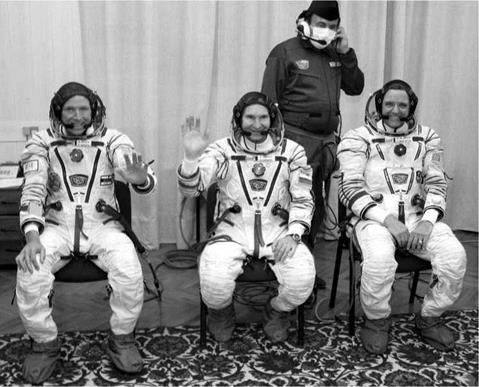. SOYUZ TMA7
Flight Crew
MCARTHUR Jr., William Surles, 54, US Army, ISS-12 commander and science officer, 4th mission
Previous missions: STS-58 (1993); STS-74 (1995); STS-92 (2000) TOKAREV, Valery Ivanovich, 52, Russian Air Force, ISS-12 Soyuz commander and flight engineer, 2nd mission Previous mission: STS-96 (1999)
OLSEN, Gregory Hammond, 60, civilian, US space flight participant
Flight Log
Greg Olsen had prepared for his mission with over 900 hours training, but had been medically disqualified from flying TMA6. His medical condition cleared up, however, and he was cleared to fly by Russian medical specialists. He was assigned to the next mission. During his week on ISS, Olsen did perform some experiments for ESA, but failed equipment and the lack of an export licence for an infrared camera prevented him completing his full programme. He did participate in the three live video and ham radio sessions with schools during the mission and spent his time Earth watching, exercising and photographing, mainly from the Russian segment. He was restricted in his activities, however, especially aboard US elements.
When the ISS-11 crew returned home, along with Olsen, the new resident crew got down to work with their own programme of experiments, maintenance and housekeeping, including two EVAs. The first of these saw the first use of US EVA suits and the Quest Airlock since April 2003. Tokarev became the first Russian to use US EVA equipment and facilities at the station. The two men installed a new camera at the end of the P1 Truss and removed a failed Rotary Joint Motor Controller (electronics box) and the Floating Potential Probe, which had been installed during STS-97 in 2000. They tossed this overboard, where it would orbit until re-entry about 100 days later.
|
ISS-7 crew wearing Sokol suits at launch-processing facility, Baikonur. L to r Olsen, Tokarev, McArthur |
They also removed a failed circuit breaker in the Mobile Transporter and replaced it with a new unit. The second EVA was rescheduled from December to February to allow more time for preparation. This EVA was from Pirs, using Russian Orlan M suits, and featured the deployment of an Orlan SuitSat, which was an old suit outfitted with a transmitter and radio, beaming faint recorded voices of children to amateur radio operators for a few days. It was expected to orbit for several weeks before eventually re-entering the atmosphere. Other tasks performed during this EVA included relocation of the Strela grapple fixture to the PMA-3 on Unity, retrieval of exterior sample cassettes and external photography. A third EVA was cancelled as unnecessary.
During their stay on the station, the two men continued repairs on Elektron, the station toilet, and in the US laboratory Destiny. The crew also continued regular exercise and science work, along with unloading a Progress re-supply vehicle, performing tests with the Canadarm2, and a communications test in preparation for receiving ATV re-supply flights. McArthur’s wife was the principle investigator for the educational payload operations and together they instigated a programme of science demonstrations for schools. Shuttle mission STS-114 had delivered much needed
supplies and alleviated the clutter of unwanted gear, but extensive science operations would have to await the arrival of the next main crew in April and the third resident crew member (Thomas Reiter) on STS-121 in July 2006.
The crew had to relocate their Soyuz twice during the mission. The first relocation from the Pirs Module to the nadir port on Zarya took place on 18 November and lasted about 19 minutes. This freed up the Pirs docking compartment for use as the airlock for the EVA that was scheduled for 7 December but moved to February. The second relocation, on 20 March, lasted 22 minutes. The crew moved TMA7 from Zarya to the recently vacated rear port of Zvezda (Progress M54), to allow TMA8 to dock with Zarya so that it would not require relocation during the six-month mission. The ISS-12 crew came home with Brazilian astronaut Marcos Pontes in TMA7 on 8 April.
Milestones
245th manned space flight
100th Russian manned space flight
93rd manned Soyuz mission
7th manned Soyuz TMA mission
40th Russian and 95th flight with EVA operations
9th ISS Soyuz mission (9S)
9th visiting mission (VC-9)
6th resident caretaker ISS crew (2 person)
3rd space flight participant
Tokarev celebrates 53rd birthday (29 Oct) in space
1st Russian to perform EVA from Quest using EMU (Tokarev)











